San Miguel Island is an isolated island located off the coast of California. It is a unique habitat for many different species of birds. The island’s diverse landscape, consisting of beaches, cliffs, and valleys, offers a variety of habitats for the resident and migratory bird species.
From seabirds like Western Gulls and Brown Pelicans to inland species like the Island Scrub-Jay, San Miguel Island is a paradise for birdwatchers. The island’s location and isolation make it an important stopover for migrating birds on their seasonal journey.
In this article, we will explore the fascinating world of birds that inhabit San Miguel Island and why it is significant to conservation efforts.
1. Rock Dove
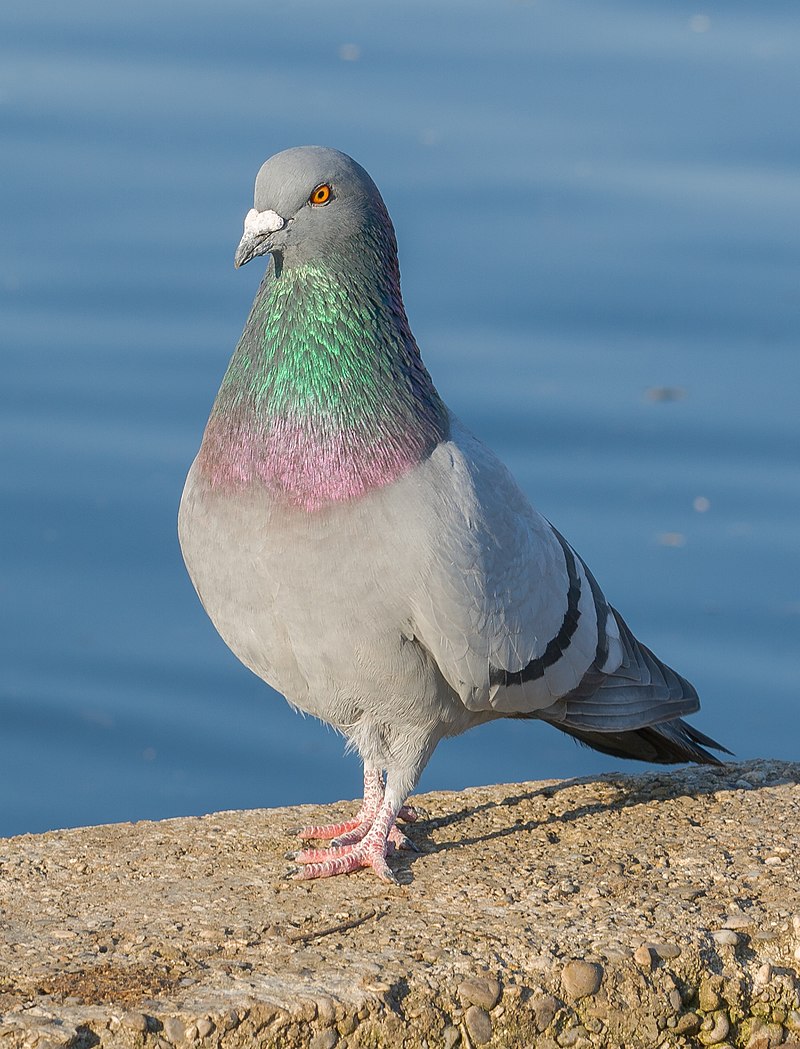
Rock dove, also known as Rock Pigeon or Common Pigeon, is a member of the bird family Columbidae.
It is considered to be an important creature worldwide due to its domestication by humans centuries ago; resulting in the modern-day Domestic pigeon which descends from this species.
Its population has increased over time because some domestic pigeons have escaped captivity and joined wild populations.
The rock dove can most easily be identified by its prominent blue-grey feathers with darker bars on wings and tail along with two black bands on each wing.
They are typically found in large flocks near cliffs or buildings but may also inhabit rural habitats such as open fields and meadows if there’s enough food available for them nearby.
Although they don’t migrate far distances like other birds, their numbers increase significantly during winter months.
When more food sources become available closeby so that they won’t need to travel too far away from home base for nourishment.Scientific classification:
| Kingdom | Animalia |
| Phylum | Chordata |
| Class | Aves |
| Order | Columbiformes |
| Family | Columbidae |
| Genus | Columba |
| Species | C. livia |
Also Featured In: Common Birds in India, Italian Birds You Should Know
2. American Wigeon
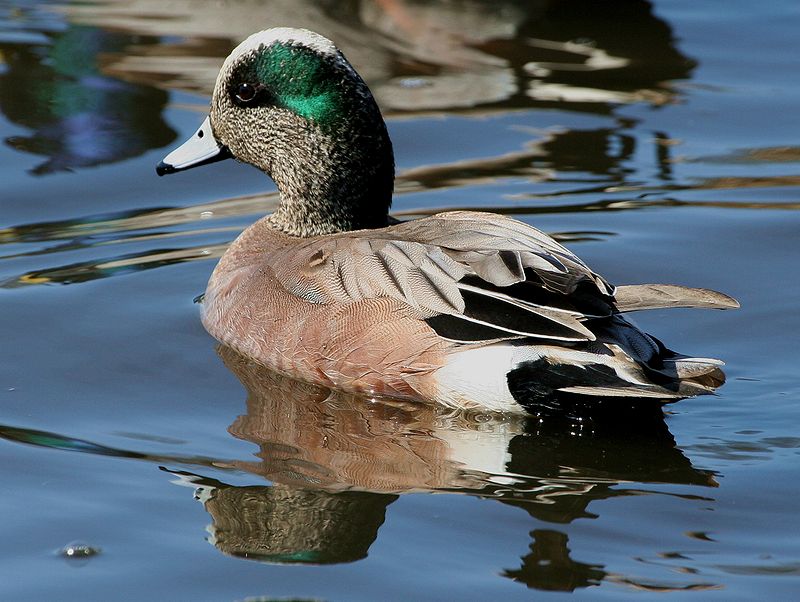
The American Wigeon, also known as the Baldpate, is a species of dabbling duck found throughout North America.
It closely resembles its Eurasian counterpart and was formally described in 1789 by German naturalist Johann Friedrich Gmelin.
This medium-sized bird has an overall grey body with white feathers on its face and belly that give it a distinctive bald appearance.
Its wings are brownish black with green speculum markings on them while the tail is dark brown or black at the base and gradually lightens near tips to become chestnut colored.
The male wigeons have purple patches on their heads during breeding season along with yellow eyes which helps differentiate them from females who have duller colors around their faces instead of bright ones like males possess.Scientific classification:
| Kingdom | Animalia |
| Phylum | Chordata |
| Class | Aves |
| Order | Anseriformes |
| Family | Anatidae |
| Genus | Mareca |
| Species | M. americana |
Also Featured In: Most Popular Bird Species in North America, Estuaries Birds
3. Pied-Billed Grebe
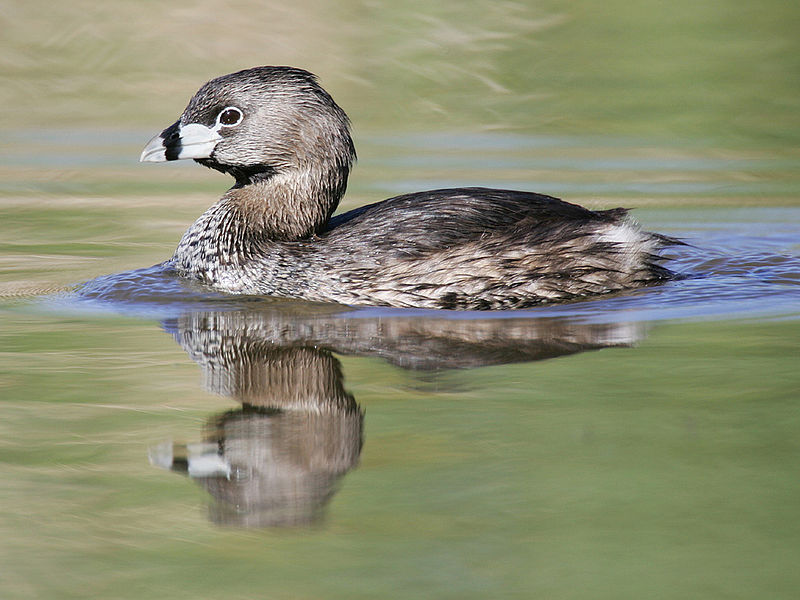
The Pied-billed Grebe is a water bird found in ponds throughout the Americas. It has earned many nicknames, including American dabchick, rail, and Carolina grebe.
This species of grebe can be recognized by its distinctive bill which is pied or mottled with black and white markings.
Its brownish body is also covered in dark spots as well as having long legs for swimming underwater to catch food such as aquatic insects and crustaceans.
The Pied-billed Grebes are monogamous birds that pair up during breeding season from spring to summer where they build their nests together on vegetation near the shoreline of lakes or slow moving rivers.
These birds are solitary outside of mating season but will form small flocks when migrating south for winter months.Scientific classification:
| Kingdom | Animalia |
| Phylum | Chordata |
| Class | Aves |
| Order | Podicipediformes |
| Family | Podicipedidae |
| Genus | Podilymbus |
| Species | P. podiceps |
Also Featured In: Top Birds Found in Mexico, Wetlands Birds You Should Know
4. Cattle Egret
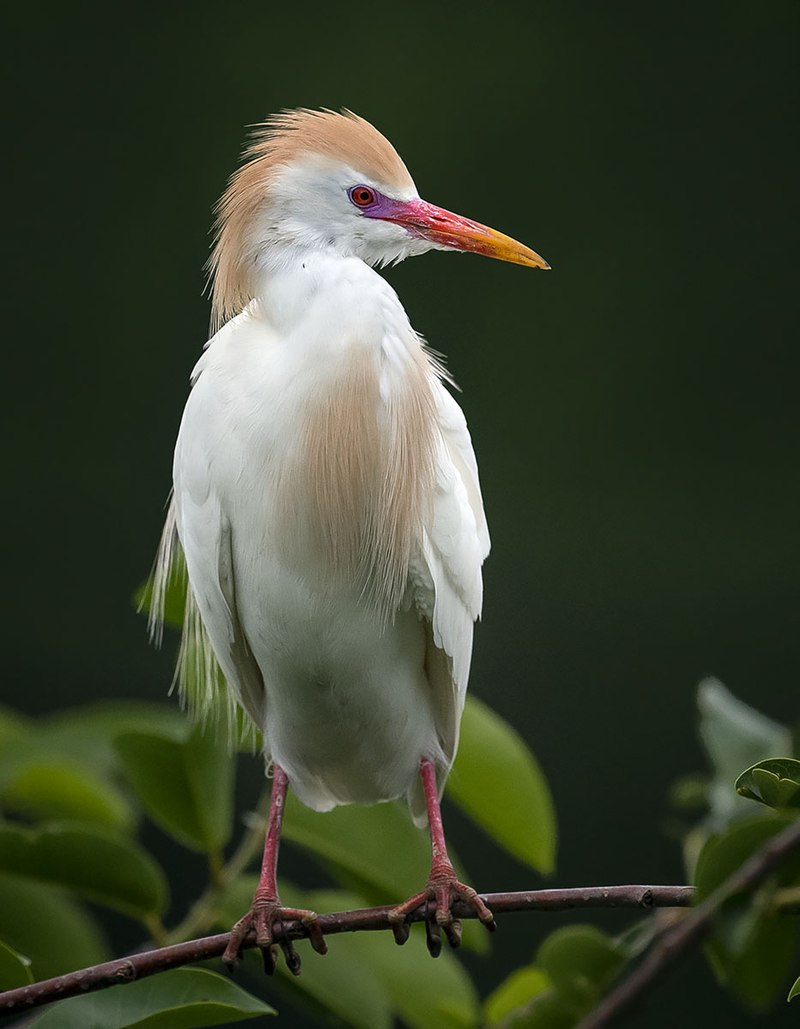
The Cattle Egret is a heron of the family Ardeidae found around the world in tropical, subtropical and warm temperate areas. It has two subspecies: western cattle egret and eastern cattle egret.
They have white plumage with buff plumes on their head, neck and back. The beak is yellowish-orange with black tip while legs are orange or yellow coloured depending on species variation.
This bird usually feeds near large herds of animals such as cows, horses etc., where it finds plenty of insects to eat like grasshoppers, crickets etc..
Its presence benefits these animals by removing ectoparasites from them which leads to healthier livestock population.
It nests colonially in trees or shrubs located close to water bodies during breeding season which generally takes place between March-June every year.Scientific classification:
| Kingdom | Animalia |
| Phylum | Chordata |
| Class | Aves |
| Order | Pelecaniformes |
| Family | Ardeidae |
| Genus | Bubulcus Bonaparte, 1855 |
| Species | B. ibis |
Also Featured In: Egyptian Birds, Asian Birds
5. Common Blackbird
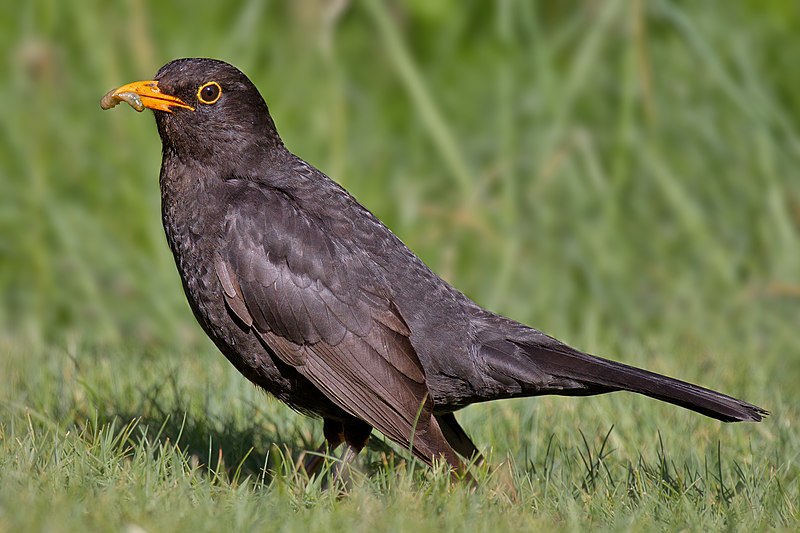
The Common Blackbird is a species of true thrush with the scientific name Turdus merula. Found in Europe, Asiatic Russia and North Africa it has also been introduced to Australia and New Zealand.
The male bird has glossy black plumage while the female’s coloration is more brownish gray.
It is known for its melodious song that can be heard throughout much of the year; typically they are seen alone or in pairs but occasionally form large flocks when food sources become available or during migration periods.
Its diet consists mainly of insects, worms, berries and other fruits as well as some human-provided foods such as bread crumbs or garbage scraps when available.
With its wide distribution range along with ease of adaptation to different habitats this species will likely remain one our most common birds around us.Scientific classification:
| Kingdom | Animalia |
| Phylum | Chordata |
| Class | Aves |
| Order | Passeriformes |
| Family | Turdidae |
| Genus | Turdus |
| Species | T. merula |
Also Featured In: Birds of United Kingdom, Birds for Your Home Garden
6. Common Wood Pigeon
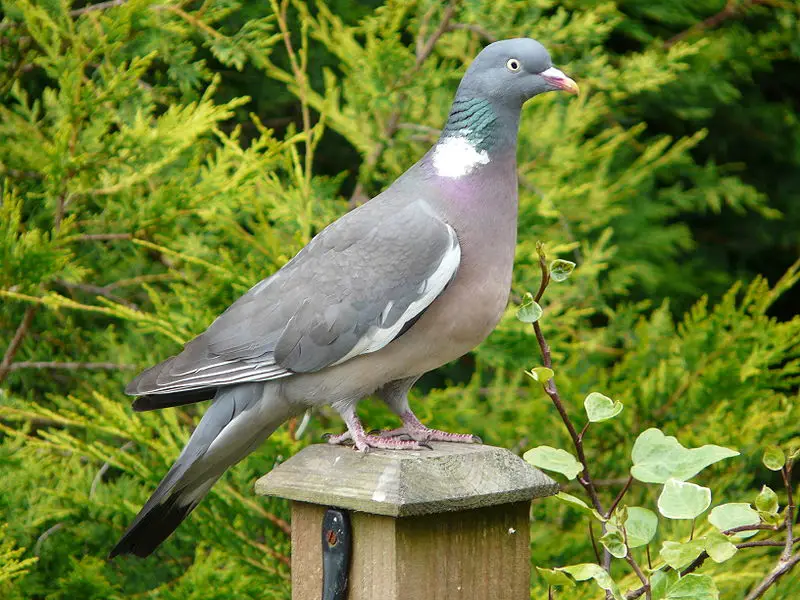
The Common Wood Pigeon is a large bird of the dove and pigeon family, native to the western Palearctic. It has grey plumage with white patches on its wings and neck.
Its head often appears darker than its body due to iridescence in some parts of its feathers. The male woodpigeons have pinkish breasts while females are more brownish-grey coloured.
These birds feed mainly on seeds, fruits, flowers and leaves but will also eat insects when available.
They breed during springtime producing 1-2 clutches per breeding season with two eggs each time which hatch after about 18 days incubation period by both parents taking turns for duty.
They make their nests from twigs collected from nearby trees or places close by and usually raise only one brood at a time making them an important part of nature’s balance as they help keep insect populations under control through their diet choices.Scientific classification:
| Kingdom | Animalia |
| Phylum | Chordata |
| Class | Aves |
| Order | Columbiformes |
| Family | Columbidae |
| Genus | Columba |
| Species | C. palumbus |
Also Featured In: Ukrainian Birds You Should Know, Birds of Sweden
7. Common Buzzard
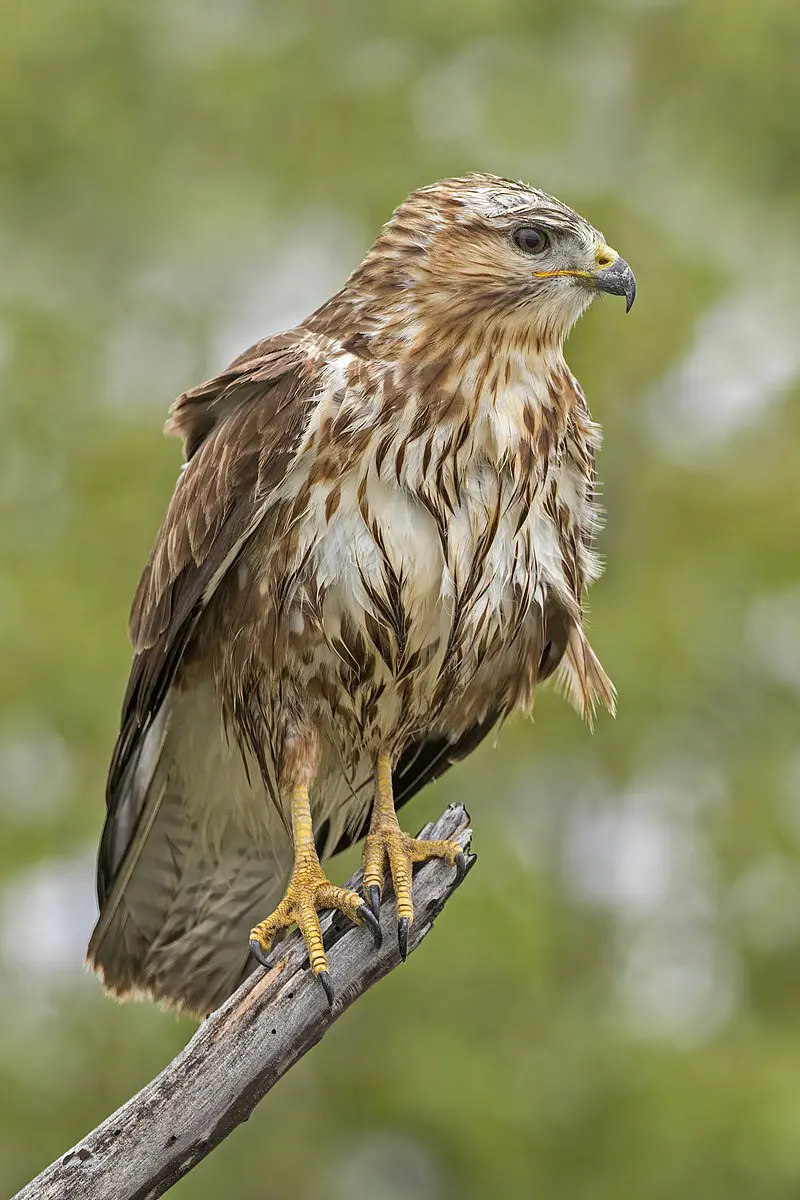
The common buzzard is a large bird of prey found across much of Europe, the Palearctic region and parts of Asia. This species has medium to dark brown plumage with lighter streaks on its body.
It has broad wings which are useful for soaring high in search of food such as small rodents, lizards, amphibians and insects.
Buzzards often hunt from a perch or while hovering above open areas like fields and meadows where they can easily spot their prey below.
They also take advantage of thermals rising up from warm ground during hot summer days to gain altitude without expending energy flapping their wings.
In addition to hunting alone, these birds will sometimes join forces with others when scavenging carrion or chasing away predators that threaten their nests full of eggs or young chicksScientific classification:
| Kingdom | Animalia |
| Phylum | Chordata |
| Class | Aves |
| Order | Accipitriformes |
| Family | Accipitridae |
| Genus | Buteo |
| Species | B. buteo |
Also Featured In: European Birds, Most Common Scotland Birds
8. Eurasian Teal
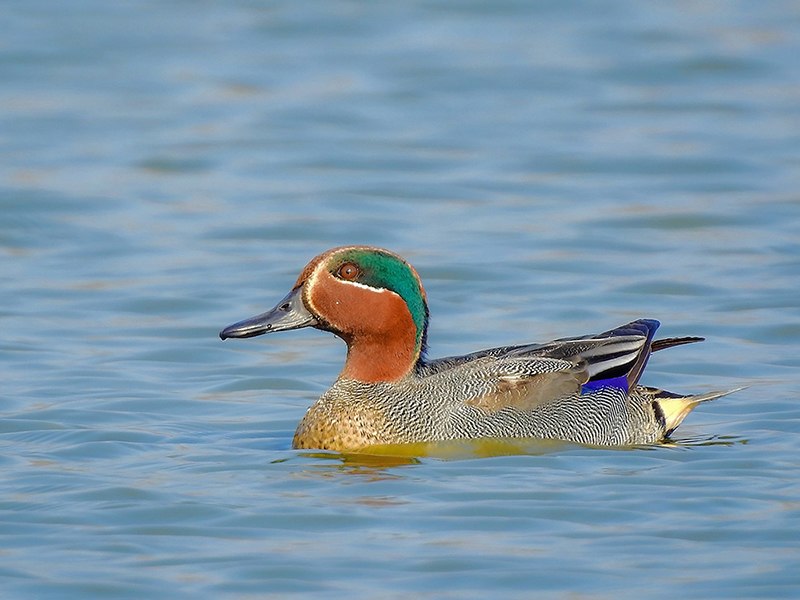
The Eurasian teal, also known as the common teal or the Eurasian green-winged teal, is a small dabbling duck that inhabits temperate Europe and Asia.
It has an unmistakable blue-green colouring which gives it its name.
During winter months they migrate south in large flocks to areas with warmer climates where there is more food available for them to feed on.
The Eurasian Teals are highly social birds; they often congregate in groups of hundreds or even thousands during migration periods.
They mostly feed on aquatic vegetation such as grasses and weeds but will occasionally hunt insects too.
These ducks make beautiful sights when flying over lakes or streams, their wings producing a distinctive whistling sound while they glide across the sky.Scientific classification:
| Kingdom | Animalia |
| Phylum | Chordata |
| Class | Aves |
| Order | Anseriformes |
| Family | Anatidae |
| Genus | Anas |
| Species | A. crecca |
Also Featured In: Flocks Birds around Us, Tokyo Birds You Need to Know
9. Great Egret

The Great Egret is a large, white bird found in many regions of the world. It has four subspecies that reside across Asia, Africa, Americas and southern Europe.
This species usually lives near bodies of water such as lakes and marshes. They are also now starting to spread into more northern areas of Europe due to climate change.
These birds have long yellow legs with an impressive wingspan for their size which allows them to soar majestically through the sky hunting for fish or amphibians in shallow waters below.
Their feathers have been used historically by Native Americans as part of traditional garments or ceremonies but this practice should be avoided today so these amazing creatures can thrive without harm from humans.Scientific classification:
| Kingdom | Animalia |
| Phylum | Chordata |
| Class | Aves |
| Order | Pelecaniformes |
| Family | Ardeidae |
| Genus | Ardea |
| Species | A. alba |
Also Featured In: Most common Birds in France, Most Common Romanian Birds
10. Great Blue Heron

The Great Blue Heron is a majestic wading bird found in many parts of North America, Central America, the Caribbean and even as far away as the Galapagos Islands.
It has an impressive wingspan which can reach up to six feet wide. Its feathers are mainly bluish-gray with brownish streaks on both its neck and chest while its head displays white plumes.
The adult herons can also be identified by their yellow bill and legs.
They live near bodies of water such as lakes, marshes or rivers where they feed on fish using a spear like motion with their sharp bills.
An all-white population exists only in south Florida and the Florida Keys making it quite unique.Scientific classification:
| Kingdom | Animalia |
| Phylum | Chordata |
| Class | Aves |
| Order | Pelecaniformes |
| Family | Ardeidae |
| Genus | Ardea |
| Species | A. herodias |
Also Featured In: Common Birds in Canada, Birds That Live in Colorado
11. Black-Tailed Godwit
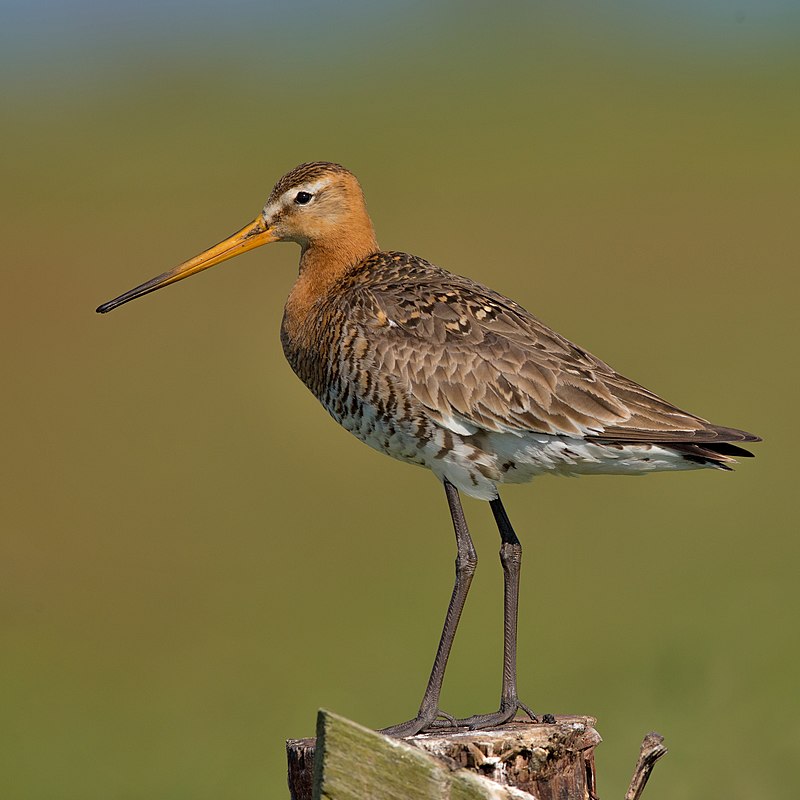
The Black-tailed Godwit is a species of large shorebird that was first described by Carl Linnaeus in 1758.
These beautiful birds have an orange head, neck and chest during breeding season while they turn to grey-brown coloration in winter.
They are easily identifiable due their black and white wingbar throughout the year. As for its habitat, these godwits breed mostly on Iceland but also across Europe, eastward through Asia Minor all the way to Mongolia; some even winter further south in Africa or India.
The Godwit has adapted well to human presence as it can be found close to wetlands near farms or villages where plenty of food is available from ploughed fields.
It’s really amazing how such a majestic bird with colorful plumage manages so successfully at this day and age.Scientific classification:
| Kingdom | Animalia |
| Phylum | Chordata |
| Class | Aves |
| Order | Charadriiformes |
| Family | Scolopacidae |
| Genus | Limosa |
| Species | L. limosa |
Also Featured In: Birds in Sri Lanka, Belarus Birds You Should Know
12. Ruddy Turnstone
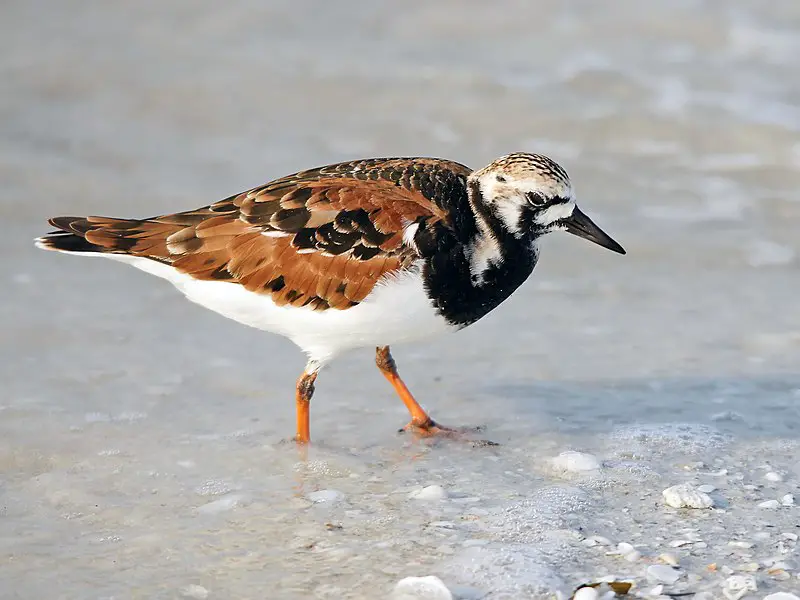
The Ruddy Turnstone is a small wading bird, belonging to the sandpiper family Scolopacidae. It has an attractive reddish-brown coloration and black patches on its back and wings.
This species breeds in northern parts of Eurasia and North America during summertime before migrating southwards in winter season to coastlines all over the world.
The Ruddy Turnstone feeds mainly on insects, mollusks, crustaceans, worms and some plant material such as seeds or berries which it finds by probing into mudflats with its bill.
It also uses stones for turning them when searching for food under rocks or pebbles along shorelines where they can often be seen darting around looking very busy.Scientific classification:
| Kingdom | Animalia |
| Phylum | Chordata |
| Class | Aves |
| Order | Charadriiformes |
| Family | Scolopacidae |
| Genus | Arenaria |
| Species | A. interpres |
Also Featured In: Birds of Netherlands, Galapagos Birds You Should Know
13. Grey Plover
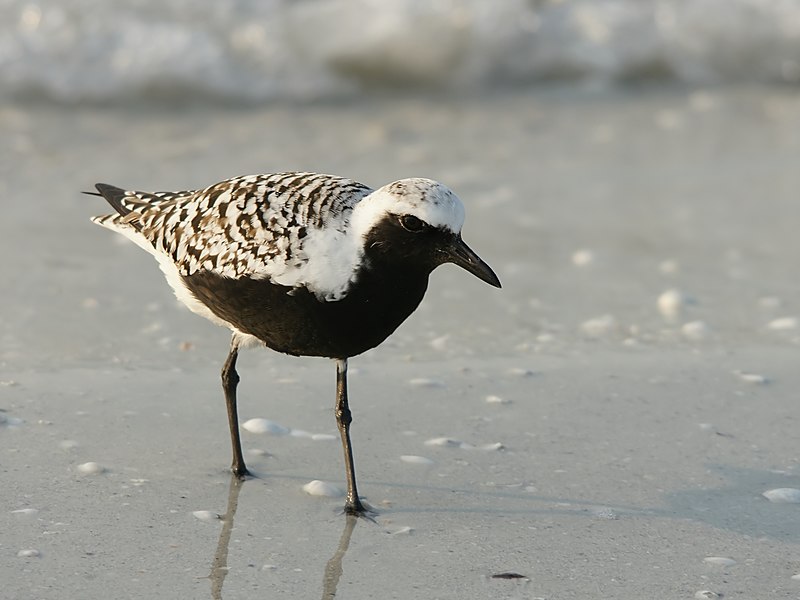
The Grey Plover is a large plover bird which breeds in the Arctic regions. It then migrates over long distances, and can be found on coastlines around the world when not breeding.
The species was first described by Swedish naturalist Carl Linnaeus in 1758 under its binomial name “Tringa squatarola”.
In addition to being known as grey plovers or black-bellied plovers, they are also sometimes referred to as “black-breasted lapwings” due to their distinctive plumage that features white underneath with dark greys above.
These birds inhabit beaches, mudflats and saltmarshes where they feed mainly on small invertebrates such as worms and insects.Scientific classification:
| Kingdom | Animalia |
| Phylum | Chordata |
| Class | Aves |
| Order | Charadriiformes |
| Family | Charadriidae |
| Genus | Pluvialis |
| Species | P. squatarola |
Also Featured In: Birds that can be Seen in Outer Banks, Tundra Birds
14. Black-Crowned Night Heron
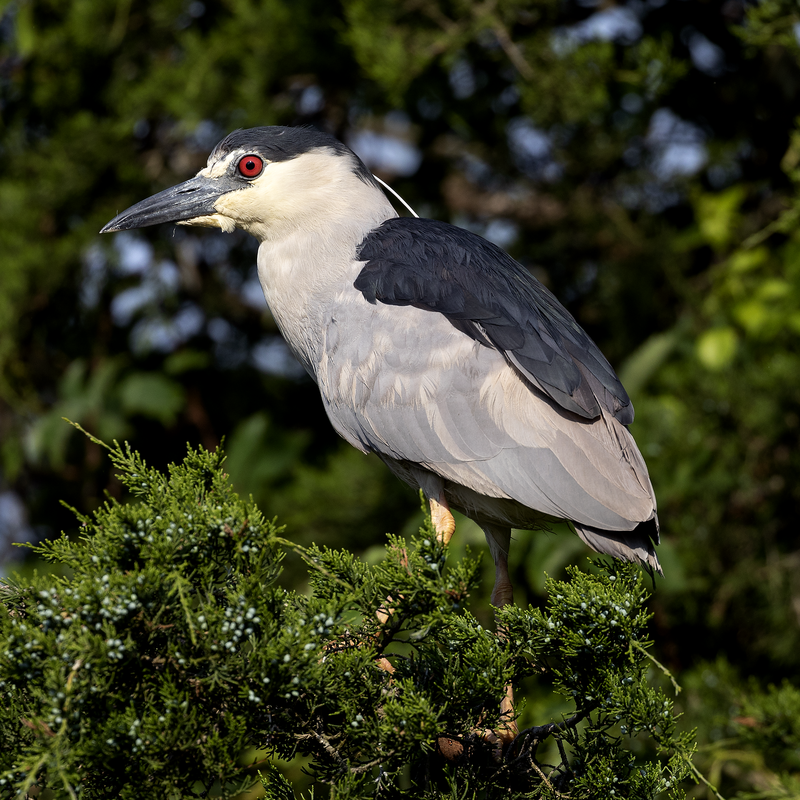
The Black-crowned night heron (Nycticorax nycticorax) is a medium-sized bird found in various parts of the world, including Europe, Asia and North and South America.
It has black crowns on its head with white feathers underneath. Its wings are greyish brown while its underparts are mostly white.
This species can be seen foraging near shallow water or along coastlines during dusk or dawn as it hunts small fish, amphibians and crustaceans.
They also feed on insects such as grasshoppers and beetles which they find in meadows close to freshwater bodies like lakes or ponds where they breed during springtime making nests using twigs lined with reeds and leaves near these waterside habitats.
In Australasia, this species hybridizes with the nankeen night heron that inhabits those areas instead; however both populations remain distinct from each other despite their overlap range regions.Scientific classification:
| Kingdom | Animalia |
| Phylum | Chordata |
| Class | Aves |
| Order | Pelecaniformes |
| Family | Ardeidae |
| Genus | Nycticorax |
| Species | N. nycticorax |
Also Featured In: Common Birds Found in Switzerland, Birds of Kauai, Hawaii
15. Eurasian Whimbrel
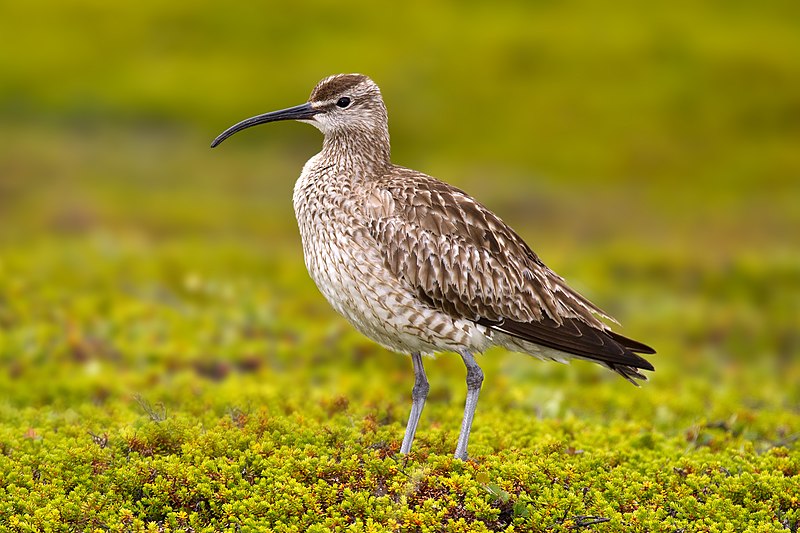
Eurasian Whimbrels are a species of wading bird commonly found in subarctic regions of Europe and Asia.
They have white rumps, long curved bills, brown wings and backs with light streaking on the lower breast.
These birds feed mainly on crustaceans, mollusks or worms they find while probing in the mud during low tide.
During breeding season they can be seen nesting near coastal areas or wetlands where food is plentiful.
This species has recently been split from Hudsonian whimbrels but some authorities still consider them to be one species due to their similarities which includes migration patterns as well as habitat preferences.
Eurasian whimbrels are an important part of many ecosystems because they help control insect populations by eating larvae before it can cause damage to crops or vegetation nearby.Scientific classification:
| Kingdom | Animalia |
| Phylum | Chordata |
| Class | Aves |
| Order | Charadriiformes |
| Family | Scolopacidae |
| Genus | Numenius |
| Species | N. phaeopus |
Also Featured In: Singapore Birds, Birds that Live in San Francisco Bay Area
16. Spotted Sandpiper
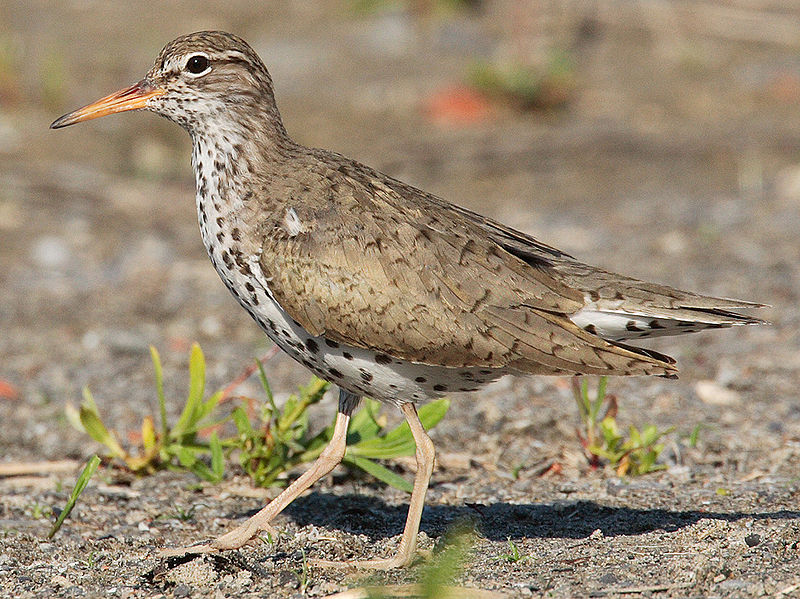
The Spotted sandpiper (Actitis macularius) is a small shorebird that can be found across North America and parts of South America.
It has an appealing spotted plumage, predominately brown in colour with white spots on the wings, tail feathers, head and neck.
The Common Sandpiper (A. hypoleucos) is its sister species which takes over geographically when the other moves away; they have been known to hybridize as well when strays settle down among breeders.
This bird was first described by Carl Linnaeus in 1766 in his twelfth edition of Systema Naturae as a migratory summer visitor to Europe but it now also occupies many habitats too like beaches, riversides and even grasslands during migration periods or for breeding season itself.
Its diet consists mainly of insects such as air-borne flies plus molluscs from shallow water areas – this makes them quite unique amongst waders.Scientific classification:
| Kingdom | Animalia |
| Phylum | Chordata |
| Class | Aves |
| Order | Charadriiformes |
| Family | Scolopacidae |
| Genus | Actitis |
| Species | A. macularius |
Also Featured In: Suriname birds, Birds in Calgary You’ll Love to See
17. Yellow-Crowned Night Heron
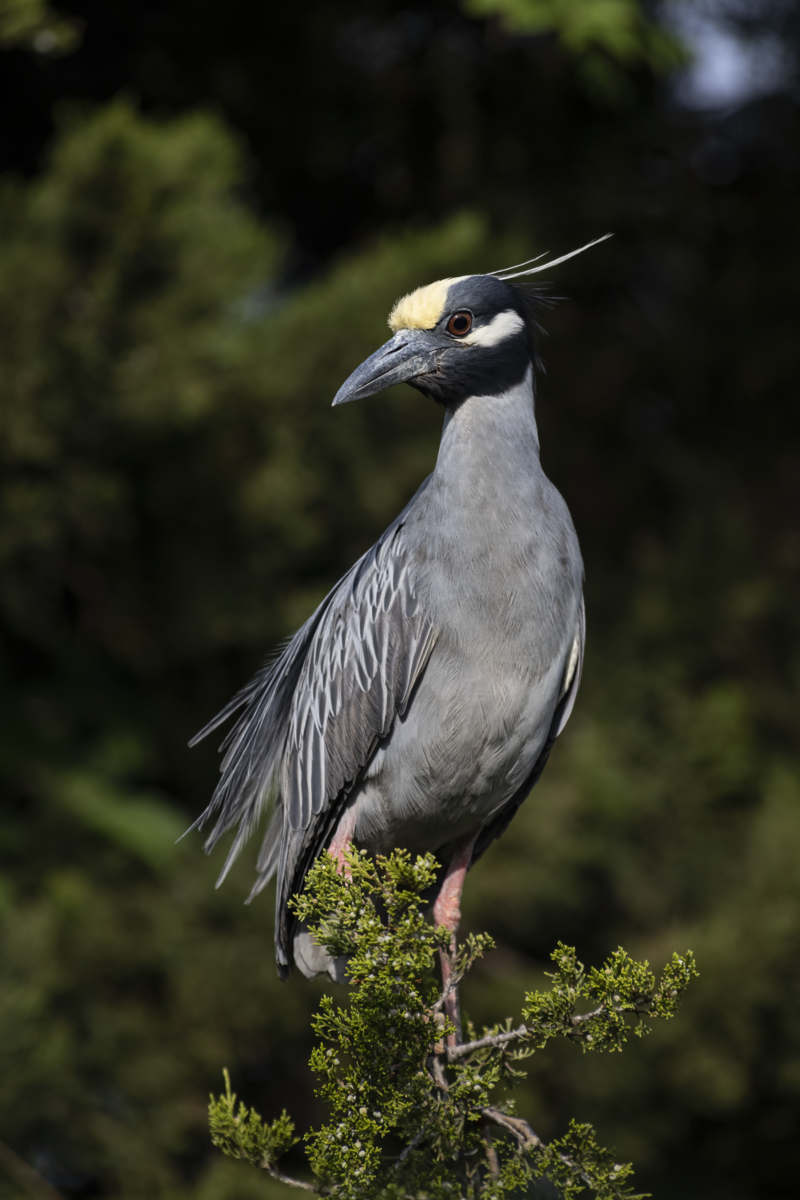
The Yellow-crowned night heron is a beautiful and unique species of bird native to the Americas. It has distinctive yellow crowns on its head, making it easy to identify among other herons.
These birds are also larger than most other types of herons, reaching up to 70 cm in length and 850 g in weight.
They usually feed on small fish or crustaceans while wading through shallow waters with their long legs.
The yellow-crowned night heron can be found near marshes or lakes during breeding season when they will build nests made from twigs high above the ground for protection against predators like raccoons and foxes.
This majestic bird is an important part of wetland ecosystems as it helps keep populations of smaller aquatic animals balanced by preying upon them.Scientific classification:
| Kingdom | Animalia |
| Phylum | Chordata |
| Class | Aves |
| Order | Pelecaniformes |
| Family | Ardeidae |
| Genus | Nyctanassa |
| Species | N. violacea |
Also Featured In: Bermuda birds, Swamps Birds You Should Know
18. Yellow-Legged Gull
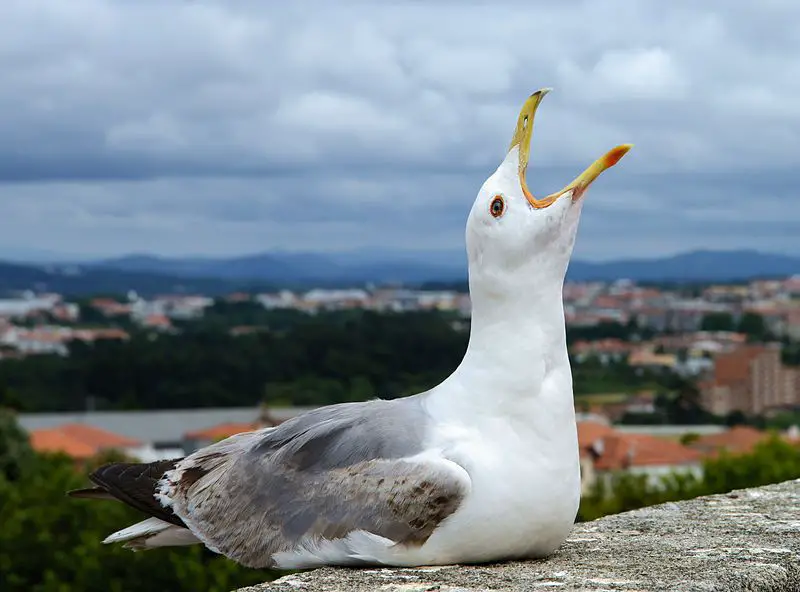
The Yellow-legged Gull is a large bird found mainly in Europe, the Middle East and North Africa.
It was previously considered to be either a subspecies of the Caspian gull or Herring Gull but has recently been identified as its own species.
The name Larus comes from Latin and likely refers to seabirds in general.
This species has yellow legs, white head with dark eyespots on each side, gray wings with black tips and pinkish legs.
They have curved bills that are yellow at the base which turn red near the tip during breeding season.
These birds feed mainly on fish but also scavenge for food when necessary such as insects, crustaceans etc.. The Yellow-legged Gull can often be seen along coastlines soaring high above fishing boats searching for their next meal.Scientific classification:
| Kingdom | Animalia |
| Phylum | Chordata |
| Class | Aves |
| Order | Charadriiformes |
| Family | Laridae |
| Genus | Larus |
| Species | L. michahellis |
Also Featured In: Gulls Species, Flight Birds You Should Know
19. Ring-Necked Duck
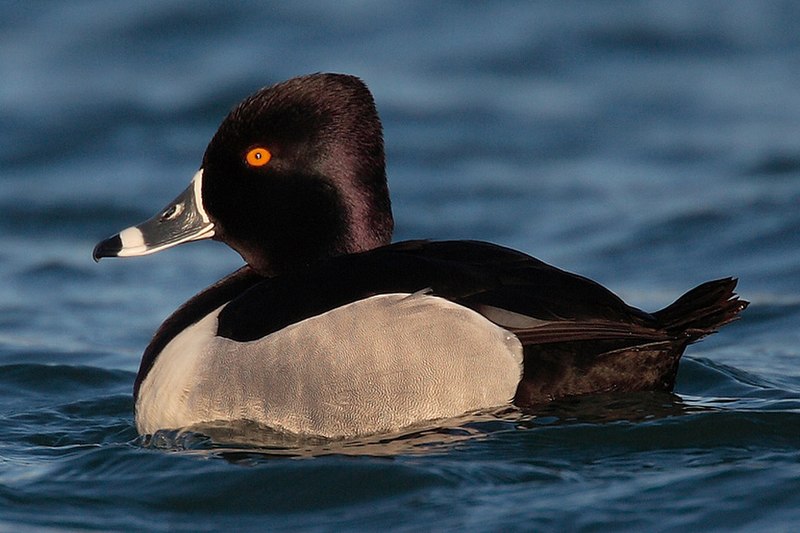
The Ring-necked duck is a popular diving bird found in freshwater ponds and lakes across North America.
They are known for their relatively small to medium size and distinctive ring around their neck, which gives them their name.
Interestingly, their scientific name is derived from a Greek word for an unidentified seabird and the Latin word for “neck.”
These ducks are great swimmers and divers, spending much of their time underwater searching for food, which mostly consists of aquatic vegetation and invertebrates.
They are also known for their striking appearance, with a beautiful coloring of black, gray, and white feathers.
The Ring-necked duck is a fascinating bird, and its unique characteristics make it a subject of interest for bird watchers and wildlife enthusiasts alike.Scientific classification:
| Kingdom | Animalia |
| Phylum | Chordata |
| Class | Aves |
| Order | Anseriformes |
| Family | Anatidae |
| Genus | Aythya |
| Species | A. collaris |
Also Featured In: Phoenix Birds You Should Know, Common Central Park Birds
20. Brown Pelican

The majestic brown pelican is a dive-feeding bird that belongs to the pelican family. It is one of the three pelican species found in the Americas and is known to dive into water to catch its prey.
From the Atlantic Coast of New Jersey to the mouth of the Amazon River, and along the Pacific Coast from British Columbia to northern Chile, including the Galapagos Islands, this bird can be found.
Its scientific name is Pelecanus occidentalis, and it has a colored brown plumage, which is its distinct characteristic.
The brown pelican belongs to the largest bird species that exist today, with a wingspan that can stretch up to seven feet long.
This bird helps maintain a balance in the ecosystem by eating smaller fish, crustaceans, and other aquatic prey.Scientific classification:
| Kingdom | Animalia |
| Phylum | Chordata |
| Class | Aves |
| Order | Pelecaniformes |
| Family | Pelecanidae |
| Genus | Pelecanus |
| Species | P. occidentalis |
Also Featured In: Birds You’ll Find in the Sea, Water Birds Live around Us
21. Northern Pintail
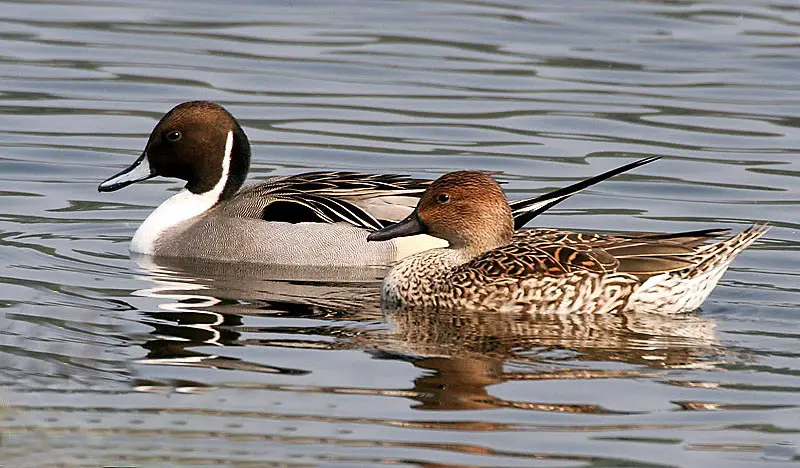
The Northern Pintail is a widespread duck species that breeds in northern parts of Europe, across the Palearctic and North America. This migratory bird winters south of its breeding range to the equator.
Unlike most birds with such a wide range, it does not have any subspecies. The male Northern Pintail has a distinctive long, thin tail and a chocolate-brown head. The female has a mottled brown body and a shorter tail.
This duck species prefers shallow wetlands or marshes for breeding and feeds on aquatic plants and insects.
The Northern Pintail is a highly migratory bird, covering great distances in search of suitable habitats.
Despite some threats, this species is not considered globally threatened, although certain populations are experiencing a decline in numbers.Scientific classification:
| Kingdom | Animalia |
| Phylum | Chordata |
| Class | Aves |
| Order | Anseriformes |
| Family | Anatidae |
| Genus | Anas |
| Species | A. acuta |
Also Featured In: Most Common Lake Birds, British Columbian Birds
22. Cory’s Shearwater
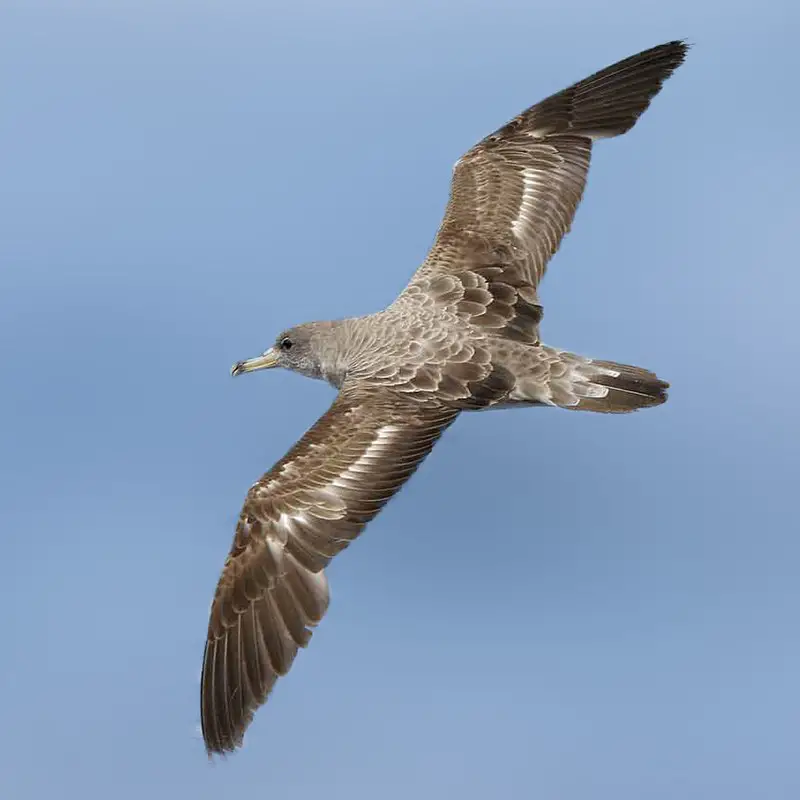
The Cory’s shearwater is a seabird from the Procellariidae family that lives in the eastern Atlantic. It breeds in colonies in rocky islands and has a wide range during the non-breeding season.
The bird was described by Charles B. Cory in 1881 and is larger in size compared to other shearwaters. It was previously classified as Scopoli’s shearwater but was later recognized as a distinct species.
Known for its long, slender wings, the Cory’s shearwater is adapted for long-distance flight and can cover great distances while foraging for food.
The bird’s plumage is mostly brown and gray with a white belly, and it has a sharply pointed beak that aids in catching prey.
The Cory’s shearwater is an important part of marine ecosystems and helps to control populations of fish and squid.Scientific classification:
| Kingdom | Animalia |
| Phylum | Chordata |
| Class | Aves |
| Order | Procellariiformes |
| Family | Procellariidae |
| Genus | Calonectris |
| Species | C. borealis |
Also Featured In: Birds that Live in the Ocean , Birds of Lanzarote
23. Azores Bullfinch
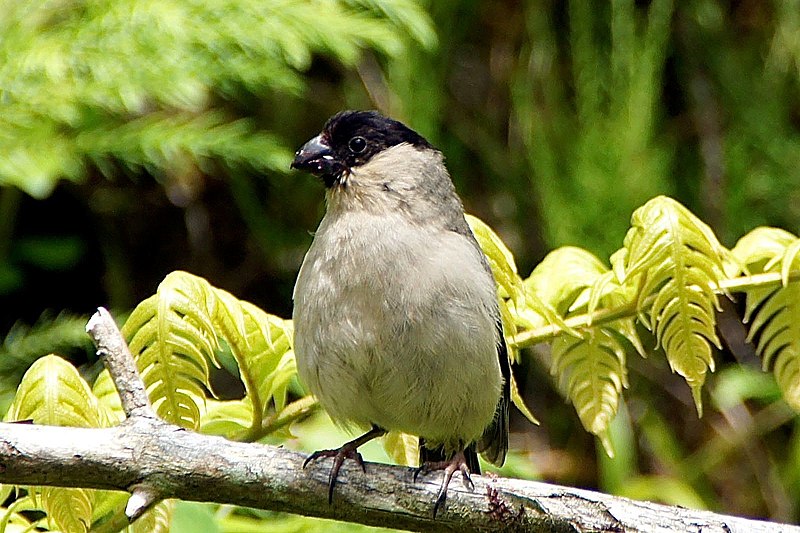
The Azores bullfinch, also known as the priolo, is a threatened passerine bird found only on São Miguel Island in the Azores archipelago.
This bird is a member of the true finch family and was first described in 1866 by Frederick Godman.
With a distinctive appearance, the Azores bullfinch has a grey head, back, and tail, with a black bib, white belly, and reddish-brown wings.
It is listed as endangered due to habitat loss and predation by introduced mammals such as rats and cats.
Conservation efforts, including habitat restoration and predator control, have been implemented to prevent its extinction.
The Azores bullfinch plays an important role in the ecosystem as a seed disperser and pollinator.Scientific classification:
| Kingdom | Animalia |
| Phylum | Chordata |
| Class | Aves |
| Order | Passeriformes |
| Family | Fringillidae |
| Subfamily | Carduelinae |
| Genus | Pyrrhula |
| Species | P. murina |
24. Yellow-Billed Cuckoo
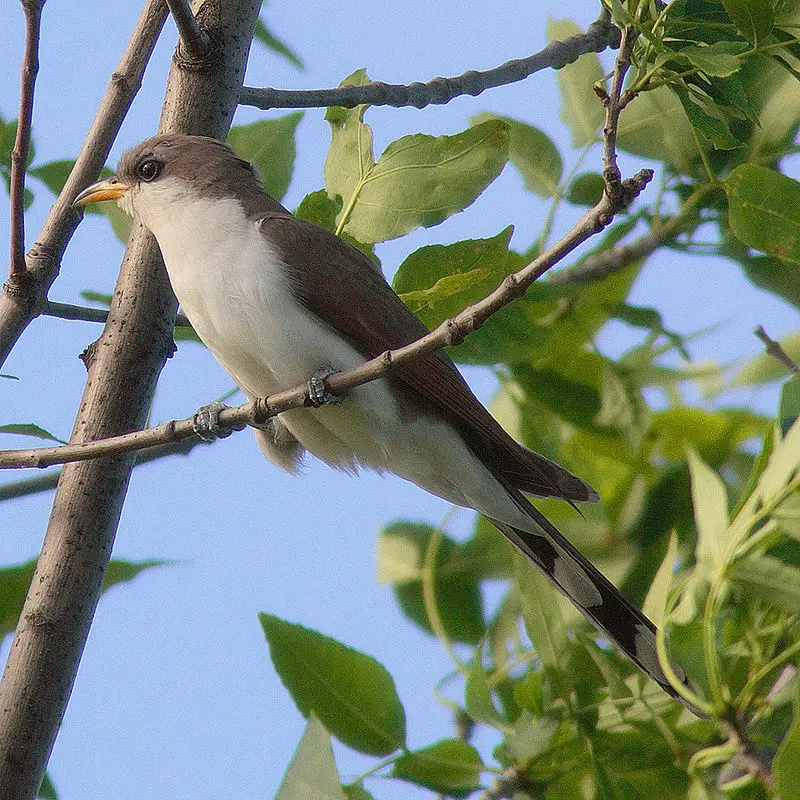
The yellow-billed cuckoo is a bird that can be found in America. It is also known as the rain crow or storm crow, as it often calls on hot days that prelude a storm.
This bird belongs to the cuckoo family, and its genus name ‘Coccyzus’ means to call like a common cuckoo in Ancient Greek. The name ‘americanus’ refers to its origin in America.
The yellow-billed cuckoo is a unique bird, with its bright yellow bill and cinnamon-brown wings. It feeds on insects, fruits, and seeds, and nests in dense vegetation near water.
While its numbers have declined in recent years due to habitat loss, the yellow-billed cuckoo remains an important species for the ecosystem.Scientific classification:
| Kingdom | Animalia |
| Phylum | Chordata |
| Class | Aves |
| Order | Cuculiformes |
| Family | Cuculidae |
| Genus | Coccyzus |
| Species | C. americanus |
Also Featured In: Birds That Live around Grand Turk Island, Native Birds Of Prince Island